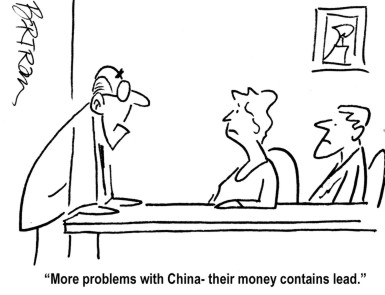 Photo courtesy of CartoonStock.com.
Photo courtesy of CartoonStock.com.
China has seen amazing economic growth in the last decade, but many of the country’s most vulnerable workers and their children are paying the price for that prosperity.
“Hundreds of thousands of children in China are suffering permanent mental and physical disabilities as a result of lead poisoning. Many of them live in poor, polluted villages next to and surrounded by lead smelters and battery factories,” said the new report – My Children Have Been Poisoned – from the Human Rights Watch.
“Often, their parents work in these factories bringing more lead into their homes on their clothes, boots, and hands,” said the report.
Joe Amon, health and human rights director at Human Rights Watch said, “We went to four provinces (Henan, Hunan, Shaanxi, and Yunnan), and in those provinces, we went to largely rural areas, having industrial factories and full of families that were just sick.
“Sometimes they didn’t even know why they were sick. They were just struggling. They just weren’t feeling well. They weren’t gaining any weight. The children were developmentally delayed, and the young weren’t walking and talking.”

Amon went on to say, “We tried to find the source of the problem and it was lead poisoning. Some of the kids were tested and the results hadn’t been returned to their families.”
The report said, “Local governments have imposed arbitrary limits on access to blood lead testing; refused appropriate treatment to children and adults with critically high lead levels; and denied the scope and severity of the lead poisoning.
“Parents said that the government officials told them that only children living within one kilometer of a factory smokestack were at risk and that milk was adequate treatment for lead poisoning.”
Dr. Mary Jean Brown, chief of the U.S. Centers for Disease Control and Prevention’s lead poisoning and prevention program, responded to the recommendation given to those parents, saying, “There is no merit to that. The most effective intervention is to stop the exposure.”
The report said that, “Under Chinese law, when an environmental hazard threatens the health of the local population, the hazard is to be alleviated or removed. In Shaanxi, rather than remove the polluting factories, the government had told local communities that they had to move.
“Villagers from Shaanxi also told Human Rights Watch that they did not know how they would survive if forced to move. Many of the villagers have small plots of land that they rely on for income.”
The report finds that, “Underpinning China’s lead poisoning epidemic is a tension between the government’s goals for economic growth and its efforts to curb environmental degradation.
“The Chinese government has developed numerous laws, regulations, and action plans designed to cut emissions, encourage more environmentally friendly industries and decrease pollution. Yet these policies are in competition with the Chinese government’s goals for economic development.”
The report adds that, “Local officials, who often have a legal or financial role in local factories, may be resistant to implementing environmentally friendly technology. Existing environmental laws often lack effective enforcement mechanisms.”
Anecdotally, the report discovered that, “In rare instances, owners of hazardous factories may face criminal charges. However, liability for contaminated industrial sites is frequently disputed, with neither current nor former owners consistently held responsible.
“Even when hazardous facilities are shut down in response to environmental concerns, they may be reopened with no changes in operation procedures.”
Reader comments and input are always welcomed!